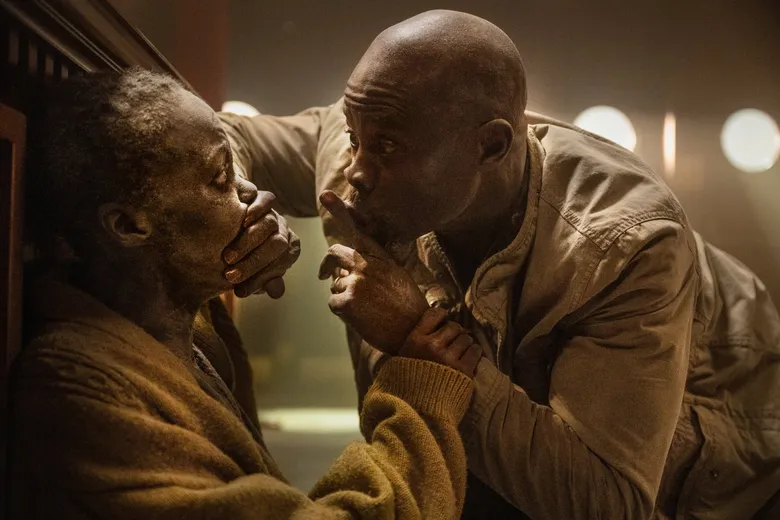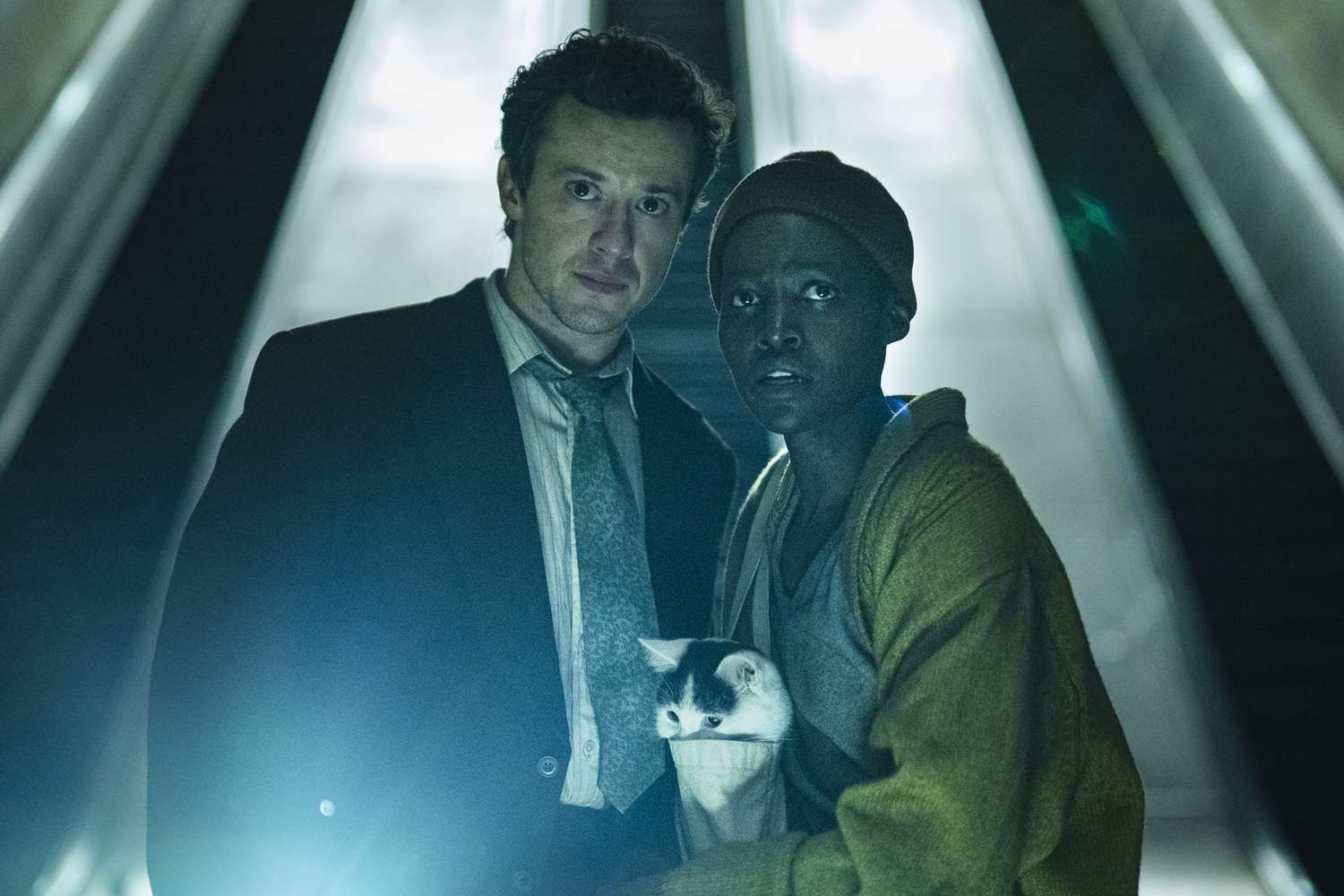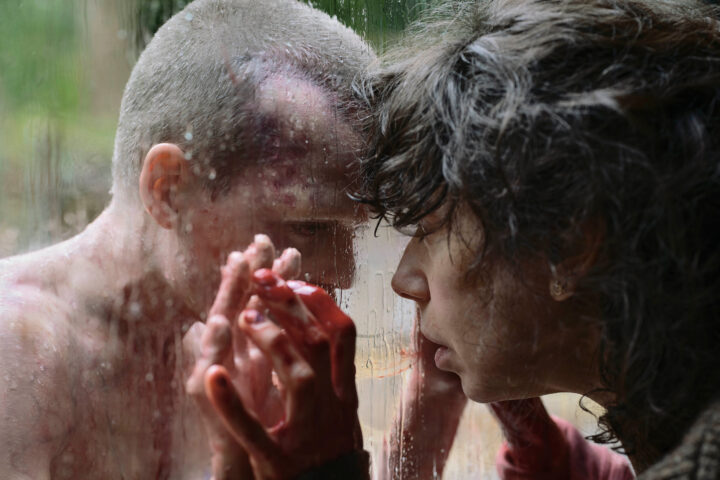Familiarity proves a slight problem for A Quiet Place: Day One, an origin story preceding the first two hit films and depicting the arrival of the deadly alien race bent on decimating humanity. The problem this time is mainly one of sameness—here we have a movie, the third in a series, that shows us nothing terribly new. Watching the spindly creatures, terrifying in prior installments, this time drop from the sky to maraud New York City, has a been-there-done-that fatigue. Throughout the film I wondered—if released in chronological order would the new installment actually feel fresh?
A few key differences inform this prequel, beginning with 2018’s A Quiet Place and 2020’s A Quiet Place Part II creator, director and star Jon Krasinski relinquishing the reins to talented helmer Michael Sarnoski (Pig), who wrote the screenplay. Secondly, there’s been a setting shift from the pastoral countryside to a quickly dystopian Manhattan (harkening to many a disaster film). This ashen war zone is frame-by-frame gorgeously art directed and shot, often in close-up, by cinematographer Patrick Scilla. There’s also a new set of characters, led by a transcendent Lupita Nyong’o in the kind of performance that elevates—and then some—a genre movie as only the finest actors can do.
Nyong’o, the Yale drama grad who won the Oscar for 12 Years a Slave and collected critics’ prizes for a galvanizing performance in Jordan Peele’s Us, stars here as stage 4 cancer patient Sam, quietly winding down in a suburban hospice under the care of a concerned nurse (Alex Wolff, underused). After poet Sam she pens a pessimistic piece on how the world is “shit,” he attempts to lift her spirits with an invitation to a lower Manhattan puppet show, but on one condition—hers—that they indulge in good old NYC pizza.
If you watch Nyong’o closely, her moment observing that puppet show is one of the best acted by an actress in a movie this year, a mix of resignation turned to wonder to melancholia. That theatrical is the last moment of normalcy before the city is besieged by an aerial invasion of vicious extraterrestrial monsters, Sarnoski staging the action as a disorienting, gray fogged war zone enveloping Sam and beloved cat Frodo (played by two cats named Schnitzel and Nico, who by the way have an Instagram following).

What follows will be familiar to anyone having seen the first two installments. “Sheltering in place” inside the theater, Sam and fellow survivors (wasting the great Djimon Hounsou) quickly surmise that the killer E.T.s are sound-averse, and the film goes mostly quiet. If not, the rules go, you are dead. Sarnoski does little to expand this premise, offering no additional revelations or developments about the creatures, their origins, intent or biology. Unlike, say, James Cameron’s 1986 action classic Aliens, the filmmaker makes little attempt to expand the series. Recall Cameron’s richly detailed alien queen and allusions to Sigourney Weaver’s maternal protector. Sarnoski not only eschews such possibilities, he actually sidelines his aliens as if their infestation is happening largely away from the film’s main plot.
So what is that plot? Essentially, Sam and Frodo (who has a habit of wandering right into and out of the action with the cool temperament of James Bond, facing down danger without breaking sweat) make their way uptown to Harlem in search of nostalgia—a pizza place Sam’s jazz musician dad took her to as a child—while the world burns around them and Sam’s mortality clock ticks.
A second character emerges in the from of a suited, Wall Street type named Eric, superbly played by Joseph Quinn (Stranger Things), who isn’t afraid of showing vulnerability, and an interesting dimension here is that Sam, who doesn’t fear death, must keep Eric calm, manage his terror and lead the pair of unlikely survivalists across a quietly war-torn city (A New York actually shot in London). While most of the population is heading to rescue boats, given that the creatures die in water—Sam, Eric and Frodo head uptown in pursuit of her personal closure. Nyong’o and Quinn make a terrific onscreen pair, and clearly Sanofski is more interested in their very tenderly emerging relationship, which really works.
Two scenes are exceptional—in the first, Sarnoski stages a creepy subterranean sequence which finds the trio pursued by a creature through a pitch black, flooded subway tunnel; such superb suspense is mostly absent from the rest of the film. And in a late exchange ranking as the film’s best scene, Eric and Sam share an extraordinary moment of play set in an abandoned jazz club amidst the chaos outside. We believe and care for both characters.

But as a horror-thriller, the film mostly doesn’t try. Seldom do we feel up close, life-or-death stakes of visceral danger, and the film lacks the filmmaking ingenuity and sequence building that Krasinski brought to its predecessors. Recall the scene in the original picture where star Emily Blunt attempts to silently give birth, wounded and in a bathtub, while a terrifying creature lurks, ratcheting up terror. Such novel shooting, cutting and scoring is missing here, along with a sustained sense of danger. And as good as Nyong’o is, her story doesn’t quite measure up to Krasinski’s notions of family—staying together, raising kids, surviving in a most unorthodox setting—that gave the earlier films gravitas.
Still, this is a showcase for the dynamic actress, whose eyes hold such pain and hope, and so much focus, that she brings depth to something that is not on the page; her emotionality essays the weight of a life slipping away, one with immense clarity about its finality but also notions on how to live out its final moments. Her urgency gives the film a significant lift and Nyong’o connects even when the plot feels a bit undercooked.
Familiarity and a creature story that doesn’t do anything new hamper A Quiet Place: Day One, which builds to a final sequence providing Eric a moment of heroism and Quinn—who really knows how to hold the screen—a nice acting moment. In the film’s closing scene, Sarnoski suggests a notion of home—perhaps you can go back again, even amidst ruins—which in Nyong’o’s hands feels earned. She’s so good that she almost makes you forget that the movie around doesn’t quite keep up, and reminds us just why she’s an Oscar winner.
2 1/2 stars



